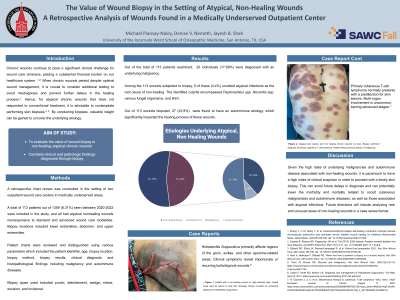Case Series/Study
(CS-104) The value of wound biopsy in the setting of atypical, non healing wounds. A retrospective analysis of wounds found in a medically underserved outpatient wound center

Chronic wounds continue to pose a significant clinical challenge for wound care clinicians, placing a substantial financial burden on our healthcare system. 1,2 When chronic wounds persist despite optimal wound management, it is crucial to consider additional testing to avoid misdiagnosis and prevent further delays in the healing process.3 Malignancies can manifest as wounds, and conversely, wounds can coexist with malignancies. Hence, for atypical chronic wounds that have not responded to conventional treatment, it is advisable to contemplate performing skin biopsies.4 5 By conducting biopsies, valuable insight can be gained to uncover the underlying etiology and assist in the identification of malignancies. The aim of this retrospective study is to evaluate the value of wound biopsy in non healing, atypical chronic wounds and correlate malignant findings diagnosed through biopsy. A retrospective chart review was conducted in the setting of an outpatient wound care center in a medically underserved area. A total of 125 patient charts were reviewed and distinguished using various parameters which included the patient name, age, biopsy location and type, biopsy results, date of biopsy, clinical diagnosis, and histopathological findings including malignancy. A total of 125 patients were included in the study and biopsy locations included lower extremities, abdomen, and upper extremities. Biopsy types used included punch, debridement, wedge, shave, excision, and incisional. A total of 105 patients were found to have no malignancy associated with their wound, while 20 (6.25%) were found to have an underlying malignancy. Given the high rates of underlying malignancies found in non healing wounds, it is paramount to have a high index of clinical suspicion in order to proceed with a timely skin biopsy. This can avoid future delay in diagnosis and can potentially lower the morbidity and mortality related to occult cutaneous malignancies. Future directions will include analyzing rare and unusual cases of non-healing wounds in a case series format.
Methods:
Results:
Discussion:
Trademarked Items:
References: 1. Zhang Y, Li M, Wang Y, et al. Exosome/metformin-loaded self-healing conductive hydrogel rescues microvascular dysfunction and promotes chronic diabetic wound healing by inhibiting mitochondrial fission. Bioact Mater. 2023;26:323-336. doi: 10.1016/j.bioactmat.2023.01.020.
2. Cassidy B, Reeves ND, Pappachan JM, et al. The DFUC 2020 dataset: Analysis towards diabetic foot ulcer detection. touchREV Endocrinol. 2021;17(1):5-11. doi: 10.17925/EE.2021.17.1.5 [doi].
3. Sibbald RG, Elliott JA, Persaud-Jaimangal R, et al. Wound bed preparation 2021. Adv Skin Wound Care. 2021;34(4):183-195. doi: 10.1097/01.ASW.0000733724.87630.d6.
4. Alavi A, Niakosari F, Sibbald RG. When and how to perform a biopsy on a chronic wound. Adv Skin Wound Care. 2010;23(3):132-2. doi: 10.1097/01.ASW.0000363515.09394.66.
5. Trent JT, Kirsner RS. Wounds and malignancy. Adv Skin Wound Care. 2003;16(1):31-34. https://www.proquest.com/scholarly-journals/wounds-malignancy/docview/222184633/se-2?accountid=7139 https://primo-tc-na01.hosted.exlibrisgroup.com/openurl/01INCARNATE/INCARNATE-S??url_ver=Z39.88-2004&rft_val_fmt=info:ofi/fmt:kev:mtx:journal&genre=article&sid=ProQ:ProQ%253Ahealthcompleteshell&atitle=Wounds+and+malignancy&title=Advances+in+Skin+%2526+Wound+Care&issn=15277941&date=2003-01-01&volume=16&issue=1&spage=31&au=Trent%252C+Jennifer+T%253BKirsner%252C+Robert+S&isbn=&jtitle=Advances+in+Skin+%2526+Wound+Care&btitle=&rft_id=info:eric/&rft_id=info:doi/.

.png)